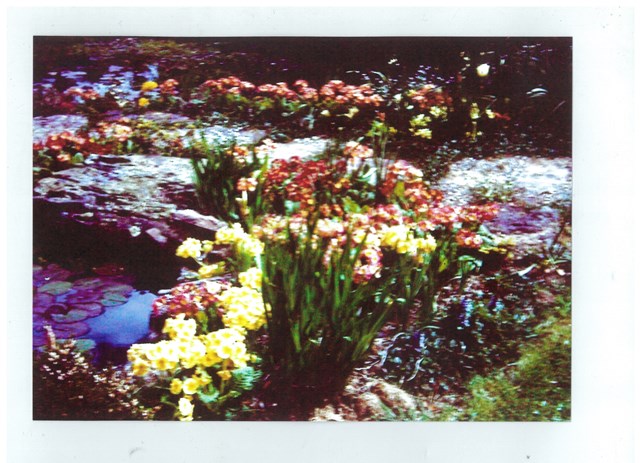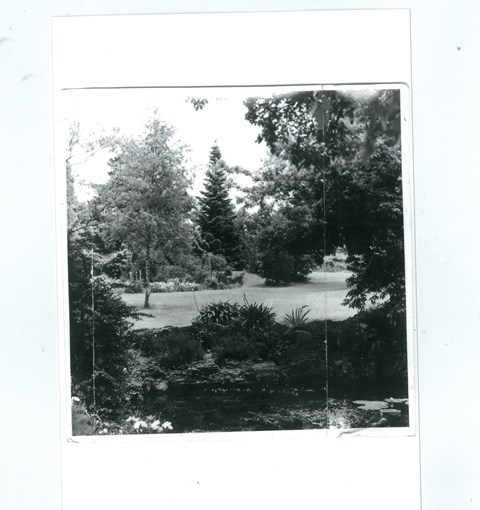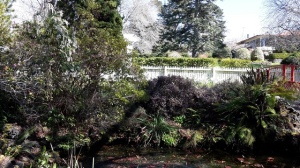The neighbouring radiatas are all down now and the stumps ground. This week we made a huge collection of vegetable scraps from Up Beet. The opportunity to make an immediate pile from the scraps plus extra coffee grounds on hand from Cassiopeia with the abundant sawdust seemed too good to miss.
Month: September 2015
In the Garden 18.9.15
Organic fertilizing of garden beds and lawns at Leura Gardens Resort
We fertilize all our garden beds in autumn and spring. At the moment our regime involves the use of Organic Life and Seasol for the garden beds and Katek Super Growth and Seasol for the lawns. On any azaleas or camellias that are not looking well we will use Kahoona for acid loving plants and/or trace elements. Compost is put out all year round as it matures and worm wee is utilised all year round too.This spring we have used 11 x 25kg bags of Organic Life and 4 x 25kg bags of Katek Super Growth. The Organic Life is in pelleted form and the Katek Super Growth is in granular form. Granular is much better for spreading on lawns.
The lawns are a crucial part of these gardens as we host weddings on them. I have done quite a bit of research into organic lawn maintenance in general and our lawns in particular. Organic lawn maintenance revolves around the soil food web (see www.soilfoodweb.com ). A strongly cycling soil food web will enable optimum growth of the plants within that web. Returning lawn clippings to the lawn with a mulching mower is only the beginning.
The soil our lawns are laid on is a dispersing sandy clay loam. The loam component does hold nutrients but it quickly leads to compaction as the loam blocks the pores in the soil necessary for the circulation of oxygen, water and nutrients and for roots to grow into. One of the main aims of our lawn maintenance therefore is to reduce compaction. Activation of the soil food web will reduce compaction and this is achieved by applying black strap molasses to feed the soil bacteria and actively aerated compost tea to add a variety and increased number of bacteria, fungi and protozoa. Topdressing with a compost based topdressing will also benefit the soil food web. A mixture of 50% compost to 50% sand is recommended. The readily available topdressing mix is 30% compost to 70% sand. I have spread 100%botany hummus (commercial compost) onto lawns but unless it is fairly dry it does not sift down through the grass to incorporate with the soil.
To further aid the resilience of our lawns we are over sowing a fine Chewings fescue lawn with tall fescue which has a deeper root system. We have found curl grubs (dusky pasture scarab) and their damage on the lawns and have introduced a predatory nematode (Entomopathogenic nematodes; see www.ecogrow.com.au ) to reduce their numbers.
So this spring we are fertilising the lawns with Katek Super Growth, adding trace elements with Seasol, we will top dress if possible, and bolster the soil food web with black strap molasses, actively aerated compost tea and worm wee. We will continue with the tea, molasses and worm wee regularly until the lawns stop growing for winter.
When the ground temperature reaches 15 C we will introduce some more predatory nematodes.
Sufficient water is crucial to an actively cycling soil food web and if there is no rain the main lawns will need to be watered with the equivalent of 25mm rain per week through the late spring, summer and into the autumn.
In the garden this week at Leura Gardens Resort 11.9.15
The spirea below is the Bridal Wreath Spirea single form. The double form is the one more readily available for sale. The double was the first to be identified by plant hunters in Japanese gardens and the wild single form identified later in Korea. This is why the wild form is the variety (see http://arnoldia.arboretum.harvard.edu/pdf/articles/2014-71-4-simply-spirea.pdf).
Spirea Update September 2016
While visiting the Baytree Nursery in Mount Victoria we came across a Spirea flowering at the same time as ours called Spirea thunbergii . I have tried to differentiate these two Spirea without success but as the prunifolia is not commonly available I suspect we have thunbergii. Thunbergii has pale lanceolate leaves, and simplifolia dark obovate leaves in the most applicable description I have found to date.
Spirea prunifolia var. simpliciflora
or S. thunbergii
History of the Fairfax brook and pond at Leura Gardens Resort
In the 1930s the gardener Hector Hood created a brook and pond for Lady Mabel Fairfax . This work is sometimes wrongly attributed to Paul Sorensen. When the pond was created the trees were still small and the pond received full sun. Now the trees have grown to the east and north and sun has become limited on parts of the garden around the pond and on the pond itself. The pink water lilies still flower but the show may be reduced because of reduced sunlight. In the oldest photos the plantings around the pond are of daffodils.
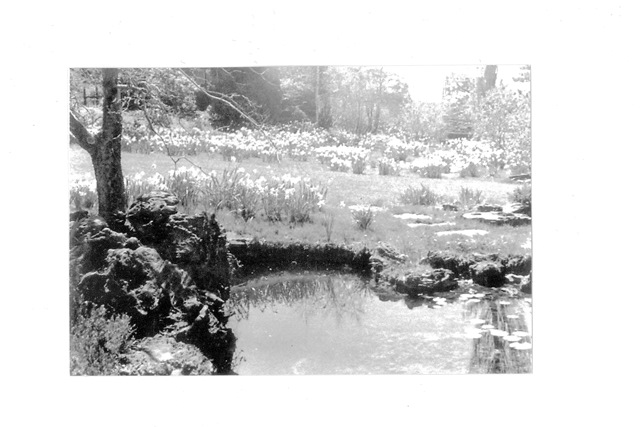
one of the earliest views across the pond toward what is now the bluebell wood (courtesy of the estate of Hector Hood)
A little later and the daffodils still seem to be there, the water lilies cover the whole surface and polyanthus have been added
In a photo that Hector Hood kept framed the shade seems to be increased although there are still a couple of daffodils flowering in the front
The photo below is one of the earliest taken after the garden was integrated into the resort. It seems the trees are bare so it does not look as shaded as the previous photo but a summer time shot might have similar shade.
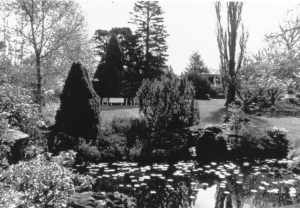
Leura Gardens Resort ownership with the Japanese lantern added by Margaret Stephens in place, possibly 1969
In the 1970s a Japanese style bridge was added over the brook (this bridge was originally painted Brunswick green) and much more recently a picket fence hedged with Camellia sassanqua has been installed around the pond.
There are still some daffodils remaining from the Fairfax garden but they are all beyond the current picket fence.



















